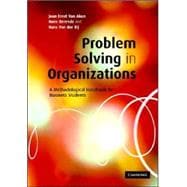
What is included with this book?
| List of figures | p. ix |
| List of boxes | p. x |
| Preface | p. xi |
| Fundamentals | p. 1 |
| Scope and nature of this handbook | p. 3 |
| Objectives and target audience | p. 3 |
| Design-focused and theory-based business problem-solving | p. 4 |
| How to use this handbook | p. 5 |
| Problem-solving projects in organizations | p. 7 |
| The nature of business problem-solving projects | p. 7 |
| The basic setup of a problem-solving project | p. 12 |
| Quality criteria for problem-solving projects | p. 15 |
| Design-focused business problem-solving | p. 17 |
| Introduction | p. 17 |
| Characteristics of design-focused business problem-solving | p. 17 |
| Problem-solving strategies | p. 19 |
| Choosing a problem-solving strategy | p. 21 |
| Designs and designing | p. 22 |
| Designing social systems | p. 27 |
| Paradigmatic starting points | p. 30 |
| Theory-based business problem-solving | p. 33 |
| Theory-based problem analysis and solution design | p. 33 |
| Solution concepts for business problem-solving | p. 34 |
| Developing knowledge for business problem-solving | p. 36 |
| The problem-solving project | p. 39 |
| Intake and orientation | p. 41 |
| General setup | p. 41 |
| The intake process | p. 42 |
| The orientation process | p. 45 |
| Describing the problem context | p. 46 |
| Problem definition | p. 46 |
| Assignment and deliverables | p. 50 |
| Project approach | p. 51 |
| Project costs and organization | p. 55 |
| Problem-solving projects in different formats | p. 56 |
| Example | p. 58 |
| Theory-based diagnosis of business problems | p. 63 |
| Introduction | p. 63 |
| Empirical exploration and validation of the business problem and its causes | p. 64 |
| Theoretical analysis | p. 70 |
| Process-oriented analysis | p. 75 |
| The diagnostic story | p. 78 |
| Alternative approaches | p. 79 |
| Final remarks | p. 81 |
| Solution design | p. 83 |
| Introduction | p. 83 |
| The deliverables of the problem-solving project | p. 83 |
| The design process | p. 84 |
| Solution design | p. 87 |
| Solution justification | p. 90 |
| Solution design: the International Imaging Systems case | p. 92 |
| Change plan design and the actual change process | p. 98 |
| The timing of change plan design | p. 98 |
| Change plan design | p. 99 |
| The change process | p. 104 |
| Change plan design: the International Imaging Systems case | p. 106 |
| Change plan design: the importance of developing organizational support | p. 110 |
| Evaluation, reflection and termination | p. 113 |
| Introduction | p. 113 |
| Project-oriented evaluation | p. 114 |
| Learning for the future | p. 119 |
| Scientific reflection | p. 122 |
| Personal and professional development | p. 124 |
| Project termination and reporting | p. 125 |
| On methods | p. 127 |
| Qualitative research methods | p. 129 |
| Qualitative versus quantitative | p. 129 |
| Unit of analysis | p. 130 |
| Case selection | p. 133 |
| Qualitative data collection methods | p. 134 |
| Qualitative methods of analysis | p. 137 |
| Selecting a method | p. 141 |
| Searching and using scholarly literature | p. 143 |
| Introduction | p. 143 |
| Types of publications | p. 144 |
| Focusing a literature review | p. 148 |
| Searching literature | p. 149 |
| Integrating ideas and findings | p. 152 |
| Quality criteria for research | p. 155 |
| Introduction | p. 155 |
| Controllability | p. 157 |
| Reliability | p. 158 |
| Validity | p. 163 |
| Recognition of results | p. 166 |
| Concluding remarks | p. 167 |
| Conclusion | p. 169 |
| Concluding remarks | p. 171 |
| References | p. 174 |
| Index | p. 181 |
| Table of Contents provided by Ingram. All Rights Reserved. |
The New copy of this book will include any supplemental materials advertised. Please check the title of the book to determine if it should include any access cards, study guides, lab manuals, CDs, etc.
The Used, Rental and eBook copies of this book are not guaranteed to include any supplemental materials. Typically, only the book itself is included. This is true even if the title states it includes any access cards, study guides, lab manuals, CDs, etc.